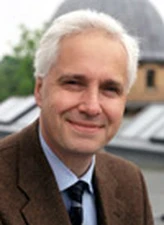Martin Claussen

The 2005 Milutin Milanković Medal is awarded to Martin Claussen for his pioneering work using interactively coupled atmosphere-biome models and Earth system models of intermediate complexity to explore the role of vegetation dynamics in palaeoclimate.
Martin Claussen was one of the first to couple models of atmospheric dynamics and vegetation, and he was the first to explicitly simulate Charney’s desert-albedo feedback in an interactively coupled atmosphere-biome model. Claussen demonstrated that atmosphere-vegetation interaction is one of the most important processes to explain palaeoclimatic changes in Northern Africa, in particular the expansion and retreat of the Sahara in the course of glacial-interglacial cycles. Claussen was the first to successfully simulate a “green Sahara” in the early Holocene. Together with his co-workers, he analysed the internal feedback and synergy factors that contribute to this greening. This work has stimulated many palaeoclimate modellers and palaeoclimatologists not only with respect to African climate dynamics, it has also stimulated the search for “hot spots” of atmosphere-biosphere interaction in other parts of the world. Moreover, Claussen found that the atmosphere-vegetation system can exhibit multiple equilibria. This discovery is of similar importance as Stommel’s study on the multi-stability of the Atlantic thermohaline circulation or Budyko’s and Sellers’ work on rapid climate change in the context of the ice-albedo feedback; these discoveries have fostered our view of the Earth system as a non-linear dynamical system.
Claussen has viewed vegetation as an interactive component of the natural Earth system, and he has actively promoted Earth system modelling by using Earth system models of intermediate complexity (EMICs – an acronym suggested by Claussen). Apart from a few exceptions, most palaeoclimate modelling activities were restricted to simplified models which were designed to demonstrate the plausibility of processes or extremely complex models which required large computational resources. Claussen realised that progress in physical understanding in palaeoclimate dynamics can be made only by explicitly simulating the interaction between all relevant components of the natural Earth system and by describing the relevant dynamics of these components in a geographically explicit way. Claussen has established an internationally highly reputed climate system modelling group at the Potsdam Institute, and he has organised an informal network of EMIC researcher who, since 1999, meet at least once a year, in particular at EGS-EGU annual meetings, to discuss progress in EMICs and to perform intercomparison experiments. Results of these workshops are published (or to be published) in international journals. Subsequently, EMICs are now recognized as an extremely useful tool in palaeoclimate modelling.
Claussen has been an active member of several scientific committees of the International Geosphere-Biosphere Programme and president of the German Meteorological Society where he has stipulated the dialogue between climate modellers and paleoclimatologists.
Publication resulting from this medal
Claussen*, M.: Late Quaternary vegetation-climate feedbacks, Clim. Past, 5, 203–216, https://doi.org/10.5194/cp-5-203-2009, 2009.
